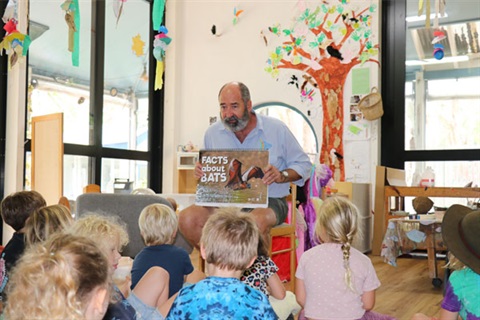Protection Flying-Foxes

Here are some of the things we are we doing to protect and manage flying-foxes in Byron Shire.
Fact about Bats
The Facts About Bats stand-up book is an A-3 photo book, with spectacular images, to help teachers explain the importance of flying-foxes to students.
The book is available for free to preschools in Byron Shire.
Contact our flying-fox project officer for a copy.
Email ccaliari@byron.nsw.gov.au
No Bat No Me
We are offering local schools a free 30-minute workshop to explore the secret network between flying-foxes and koalas.
Contact our flying-fox project officer to book a workshop.
Email ccaliari@byron.nsw.gov.au
Find out more about what can be done to protect our flying-foxes.
Habitat Restoration
From 2019 to 2023 we have restored more than 80 hectares of Eucalyptus Forest, increasing the availability of food for both koalas and flying-foxes.
Flying-fox Camp Monitoring
Since 2012, we have monitored Grey-headed and Black Flying-fox populations four times per year. Monitoring occurs in February, May, August and November as part of the National Flying-Fox Monitoring Programme (NFFMP).
Our monitoring shows that flying-fox numbers vary a lot over the year and from year to year. Flying-foxes never stay in one place for long, they move around following plants that are in fruit and flower and can travel over 5000 km in one year!
Flying-fox Camps in Byron Shire
There are 16 known flying-fox camps in the Byron Shire. We manage 5 camps located in:
- Mullumbimby
- Bangalow (Paddy's Creek camp)
- Bangalow (Byron Creek camp) – new camp emerged in 2020
- Byron Bay (Middleton Street Camp)
- Suffolk Park (Beech camp)
We are working with community members to help manage these camps through the Byron Shire Flying-fox Camp Management Plan 2018 - 2023.(PDF, 38MB)
We have developed Vegetation Management Plans for each camp. To date 2.3 hectares of new habitat has been planted and 5 hectares of habitat has been restored. Pest animal management and erosion control is also carried out at the camps to improve the natural environment.
Report injured animals
If you find an injured flying-fox do not handle it. Call an expert wildlife carer for help. If you are unable to wait for someone to arrive, pass on details of the flying-foxes exact location for to help locate them.
It is important not to touch flying-foxes as like all animals they can carry diseases. Catching a virus from a flying-fox is extremely unlikely however the NSW Health website provides information on the Australian Bat Lyssavirus and Hendra virus.